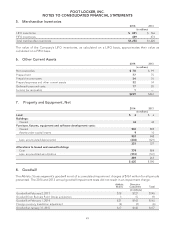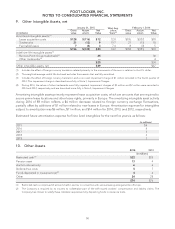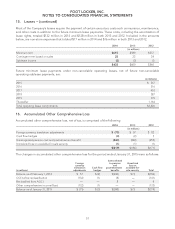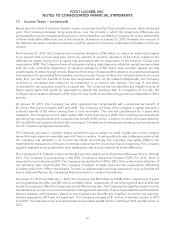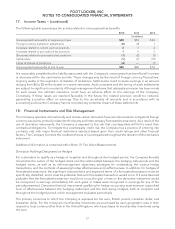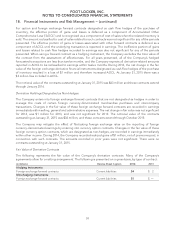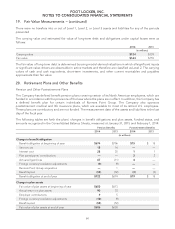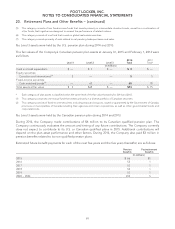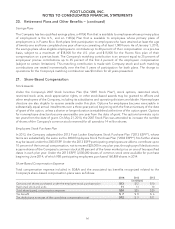Foot Locker 2014 Annual Report Download - page 79
Download and view the complete annual report
Please find page 79 of the 2014 Foot Locker annual report below. You can navigate through the pages in the report by either clicking on the pages listed below, or by using the keyword search tool below to find specific information within the annual report.FOOT LOCKER, INC.
NOTES TO CONSOLIDATED FINANCIAL STATEMENTS
17. Income Taxes − (continued)
Based upon the level of historical taxable income and projections for future taxable income, which are based
upon the Company’s strategic long-range plans, over the periods in which the temporary differences are
anticipated to reverse, management believes it is more likely than not that the Company will realize the benefits
of these deductible differences, net of the valuation allowances at January 31, 2015. However, the amount of
the deferred tax asset considered realizable could be adjusted in the future if estimates of taxable income are
revised.
As of January 31, 2015, the Company has a valuation allowance of $6 million to reduce its deferred tax assets
to an amount that is more likely than not to be realized. A valuation allowance of $3 million relates to the
deferred tax assets arising from a capital loss associated with an impairment of the Northern Group note
receivable in 2008. The Company does not anticipate realizing capital gains to utilize the capital loss associated
with the note receivable impairment. A valuation allowance of $2 million was recorded against tax loss
carryforwards of certain foreign entities. Based on the history of losses and the absence of prudent and feasible
business plans for generating future taxable income in certain foreign entities, the Company believes it is more
likely than not that the benefit of these loss carryforwards will not be realized. Additionally, the Company
recorded an unrealized loss related to its investment in an auction rate security. This loss, if and when
recognized for tax purposes, would be a capital loss. The Company has not identified any reliable sources of
future capital gains that would be generated to absorb this potential loss. In recognition of this risk, the
Company has a valuation allowance of $1 million for any loss that would be recognized upon disposition of this
security.
At January 31, 2015, the Company has state operating loss carryforwards with a potential tax benefit of
$2 million that expire between 2015 and 2034. The Company will have, when realized, a capital loss with a
potential benefit of $3 million arising from a note receivable. This loss will carryforward for 5 years after
realization. The Company has U.S. state credits of $1 million that expire in 2024. The Company has international
operating loss carryforwards with a potential tax benefit of $3 million, a portion of which will expire between
2015 and 2034 and a portion of which will never expire. The state and international operating loss carryforwards
do not include unrecognized tax benefits.
The Company operates in multiple taxing jurisdictions and is subject to audit. Audits can involve complex
issues that may require an extended period of time to resolve. A taxing authority may challenge positions that
the Company has adopted in its income tax filings. Accordingly, the Company may apply different tax
treatments for transactions in filing its income tax returns than for income tax financial reporting. The Company
regularly assesses its tax positions for such transactions and records reserves for those differences.
The Company’s U.S. Federal income tax filings have been examined by the Internal Revenue Service through
2013. The Company is participating in the IRS’s Compliance Assurance Process (‘‘CAP’’) for 2014, which is
expected to conclude during 2015. The Company has started the CAP for 2015. Due to the recent utilization of
net operating loss carryforwards, the Company is subject to state and local tax examinations effectively
including years from 1996 to the present. To date, no adjustments have been proposed in any audits that will
have a material effect on the Company’s financial position or results of operations.
At January 31, 2015 and February 1, 2014, the Company had $40 million and $48 million, respectively of gross
unrecognized tax benefits, and $39 million and $46 million, respectively, of net unrecognized tax benefits that
would, if recognized, affect the Company’s annual effective tax rate. The Company has classified certain income
tax liabilities as current or noncurrent based on management’s estimate of when these liabilities will be settled.
Interest expense and penalties related to unrecognized tax benefits are classified as income tax expense.
Interest expense for 2014 was not significant. The Company recognized $1 million of interest income, in 2013
and 2012. The total amount of accrued interest and penalties was $2 million in 2014 and 2013, and $3 million in
2012.
56





